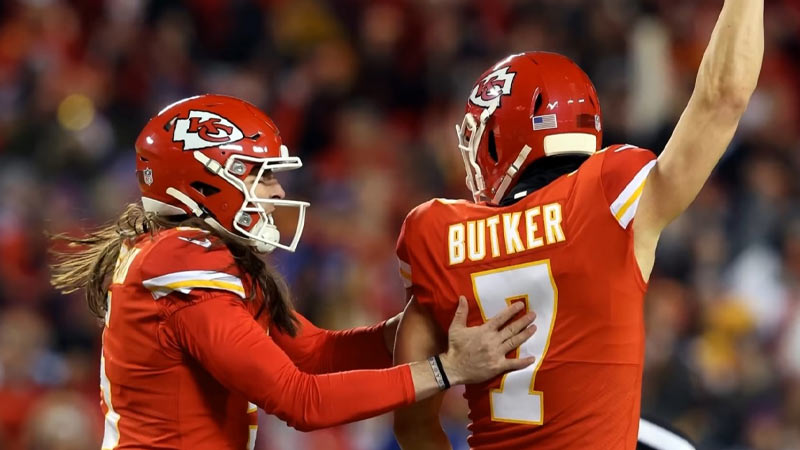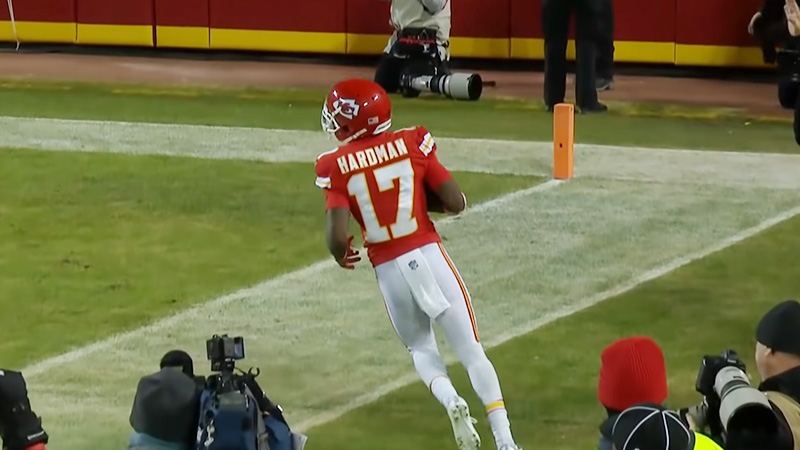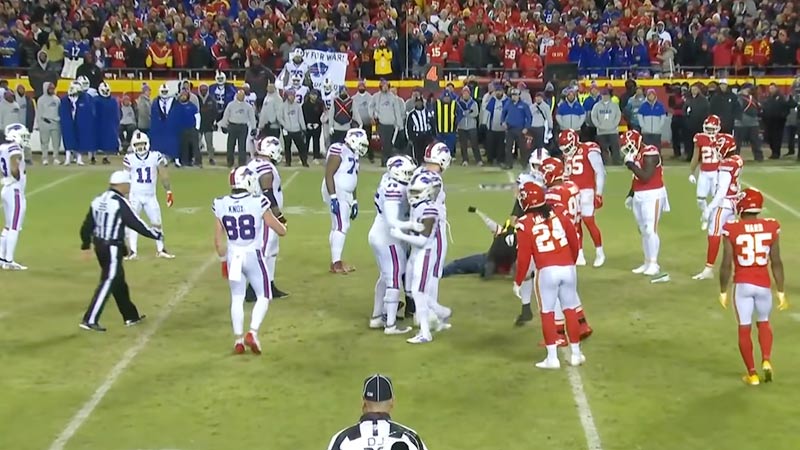In the electrifying world of the National Football League (NFL), every game is a heart-pounding battle that can culminate in thrilling victories or heartbreaking defeats.
Yet, amid the drama and spectacle, there’s an outcome that leaves both players and fans scratching their heads – a tie game. So, how does an NFL game end in a tie? Yes, it’s possible for an NFL contest to conclude without a clear winner or loser.
In this exploration, we dive into the rarely seen but not unheard-of phenomenon of tied NFL games. While these occurrences are relatively rare, they pose intriguing questions about the dynamics of football, the rulebook, and the strategies employed by teams in the face of deadlock.
So, let’s unveil the mystery behind NFL ties, understanding how these unique conclusions can affect the playoff picture and the legacy of players and coaches.
How Does an NFL Game End in a Tie?
In this section, we delve into the mechanics and scenarios that can lead to an NFL game ending in a tie, and we examine the consequences and strategies involved when the scoreboard ultimately remains balanced.
The Basics of NFL Overtime
To understand how an NFL game can end in a tie, it’s crucial to first grasp the basics of NFL overtime rules.
Traditionally, NFL games consist of four quarters, each lasting 15 minutes, for a total of 60 minutes of regulation play. If the score is tied at the end of the fourth quarter, the game proceeds to an overtime period.
Overtime Structure
Overtime in the NFL consists of a 10-minute period in regular-season games unless the first possession results in a touchdown. If the team receiving the kickoff scores a touchdown on their opening possession, they win the game.
However, if they score a field goal, the opposing team has a chance to possess the ball and either tie the game with a field goal or win with a touchdown. If the game remains tied after both teams have had one possession, the game ends in a tie.
Rare Instances of Ties
Tied games in the NFL are indeed infrequent. In recent years, rule changes have been implemented to reduce the likelihood of ties and promote a definitive outcome.
Prior to these changes, ties were more common. Nevertheless, ties can still occur, often leading to discussions about their implications for the teams involved.
Rule Changes to Reduce Ties

In an effort to minimize ties, the NFL modified its overtime rules in 2012. Previously, the game would end in a tie if neither team scored in the 15-minute overtime period.
However, under the revised rules, both teams now have an opportunity to possess the ball in overtime, except if the first possession results in a touchdown. This change has led to fewer ties and more decisive outcomes.
Playoff Implications
Ties can have significant consequences for teams, especially when it comes to playoff scenarios. In the NFL, a win is highly valuable in the quest for a playoff berth.
When teams tie, they miss out on an opportunity to secure a valuable victory, which can be a critical factor when playoff seeding is determined.
Coaching Strategies
Coaches often find themselves in a dilemma when games are tied. In the closing moments of regulation play, they must decide whether to play conservatively, run down the clock, and settle for overtime or take risks to attempt a game-winning drive.
Player Legacies
Tied games can also affect the legacies of players and coaches. When evaluating the careers of football greats, statistics such as wins and losses often play a significant role.
Ties, while not counted as losses, can still influence the perception of a player’s or coach’s ability to secure victories.
The Historical Significance of Ties
Throughout the history of the NFL, tied games have occasionally played pivotal roles in determining champions and playoff berths.
In the early days of the league, ties were more common due to different overtime rules. These ties sometimes factored into championship races, emphasizing their historical significance.
The Role of Rule Changes
The reduction in ties in recent years can be attributed to the rule changes that allow both teams an opportunity to possess the ball in overtime. This change ensures a more equitable and exciting conclusion to games and minimizes the likelihood of ties.
Fan Perspectives
From a fan’s perspective, ties can evoke mixed emotions. While they may leave viewers without the satisfaction of a clear victor, they also add an element of unpredictability and drama to the sport. Tied games are often memorable for the tense moments leading up to the conclusion.
How Often Have There Been Ties In NFL Games?

Ties in NFL games have become increasingly rare in recent years due to rule changes aimed at ensuring a definitive outcome. However, throughout the league’s long history, ties were more common in the early days.
To understand the frequency of ties in NFL games, we need to explore their historical context and the factors that have contributed to their decline.
Early Days of the NFL
Ties were relatively common in the early years of the NFL, primarily because of different overtime rules.
The NFL was founded in 1920, and during its early decades, games could indeed end in ties without a clear winner. Overtime rules were not firmly established, and many games ended with scores like 0-0 or 7-7.
Evolution of Overtime Rules
Over time, the NFL recognized the need for a more decisive outcome, and various iterations of overtime rules were introduced. One significant change occurred in 1974 when sudden death overtime was introduced.
In this format, the first team to score any points (even a field goal) in overtime would win the game. While this reduced ties, it sometimes led to games ending with a field goal without the opposing team possessing the ball.
Reduction in Overtime Ties
The most significant reduction in ties came with rule changes in 2012. Before these changes, if neither team scored during the 15-minute overtime period, the game would end in a tie.
However, the 2012 rule change allowed both teams an opportunity to possess the ball unless the first possession resulted in a touchdown. This change significantly decreased the likelihood of ties, as both teams had a fair chance to win in overtime.
Frequency of Ties in Recent Years

Since the rule change in 2012, ties in the NFL have become exceedingly rare. Prior to that, in the preceding decade, there were a handful of ties, but they were still infrequent.
For example, the 2008 NFL season saw two ties, the first in six years. However, in the seasons following the 2012 rule change, ties became far less common. In fact, the 2012 rule change itself aimed to reduce ties and encourage more decisive outcomes.
The result was fewer games ending in ties, as the new format allowed both teams an opportunity to possess the ball unless the first possession resulted in a touchdown.
Factors Contributing to Fewer Ties
Several factors have contributed to the reduction of ties in the NFL:
Overtime Rule Changes
As mentioned earlier, the most significant reduction in ties came with the 2012 rule change that allowed both teams an opportunity to possess the ball in overtime.
Strategies and Coaching
Teams and coaches have adjusted their strategies to be more aggressive in overtime, aiming for touchdowns rather than settling for field goals. This shift in approach has reduced the likelihood of ties.
Increased Scoring
The modern NFL has seen an increase in scoring, with more high-scoring games. This trend has made it less likely for games to end in ties due to the sheer number of points being scored.
Significance of Ties
Tied games, while increasingly rare, still carry significance in NFL history. Some tied games have had a profound impact on playoff races and championship standings.
For example, a tie can mean the difference between a team making the playoffs or falling short. Tied games can also be memorable for the circumstances surrounding them, such as weather conditions, dramatic plays, or strategic decisions made during overtime.
FAQs
Do NFL games end in a tie?
NFL games ending in a tie are statistically rare. Over the past few decades, ties have become increasingly infrequent due to rule changes and the evolving nature of the sport. There are typically only a few ties in an entire NFL season, if any.
What happens in the NFL standings when a game ends in a tie?
In the NFL standings, a tie is recorded as half a win and half a loss for each team involved. This means that both teams receive 0.5 points in the win-loss column. Ties can affect playoff scenarios, as they are counted when determining a team’s overall winning percentage.
When did the NFL change its overtime rules to reduce ties?
The NFL made significant changes to its overtime rules in 2012 to reduce ties. Before this change, games could end in ties if neither team scored during the 15-minute overtime period. The 2012 rule change allowed both teams an opportunity to possess the ball.
What is the most famous tie game in NFL history?
One of the most famous tie games in NFL history is the “Heidi Game,” which occurred in 1968 between the New York Jets and the Oakland Raiders. The game cut away to show the movie “Heidi” with just minutes left, leading to a controversial finish that ended in a tie.
Do tied games affect tiebreaker scenarios for playoff qualification?
Tied games can indeed impact tiebreaker scenarios for playoff qualification. In cases where teams have the same win-loss records, ties are counted to determine their overall winning percentages. Depending on the situation, a tie can either help or hinder a team’s chances of making the playoffs.
Conclusion
In this journey through the world of tied NFL games, we’ve discovered that these rare occurrences can leave a lasting impact on teams’ playoff aspirations, individual player legacies, and coaching strategies.
The NFL’s overtime rules, designed to break ties, have evolved over the years, striking a delicate balance between fairness and the preservation of player health. In recent seasons, changes have aimed to reduce the likelihood of ties, making the endgame even more thrilling.
Tied games, though somewhat enigmatic, remind us that football is a sport where anything can happen. A single play, a missed opportunity, or a brilliant defensive stand can determine the outcome.
While ties might leave fans without the satisfaction of a clear victor, they add an extra layer of unpredictability that makes every NFL game an unforgettable spectacle. So, the next time you watch an NFL game, appreciate the rarity of a tie.







